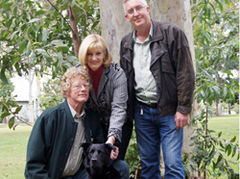KOALA data collection in Logan - can you help?
 The announcement by Logan City Council that it will ask residents to collect information regarding the sex, health, location, behaviour and the tree species in which koalas are located is welcome. There is an acknowledgement that koalas are an important part of our environment.
The announcement by Logan City Council that it will ask residents to collect information regarding the sex, health, location, behaviour and the tree species in which koalas are located is welcome. There is an acknowledgement that koalas are an important part of our environment.
We are particularly keen to understand how Logan City Council's koala dog Oscar - pictured aside will complement the koala survey methods used by volunteer resident "citizen scientists" to provide more accurate local habitat mapping city wide.
Although curently Logan may be blessed by 78.9% tree cover that is subject to rapid clearing of sustantial areas for new housing developments, industrial development and the crisscrossing of roads creating a patchwork of disconnected areas of habitat which make no provisions for safe movement of any of our local fauna.
Read council's news re the koala dog here.
As yet there is no online process to become involved in the survey. Read about it here. Phone 3412 3412 for more information.
It is useful to understand that koalas' food source tree the eucalypt is eaten very selectively - only 17 out of 700 different gums are favoured locally growing gums - and then there are other factors not yet understood. In order for all plants to reproduce pollination has to occur and the pollinator of eucalypts is the flying fox.
Our much loved koala and the targeted maligned and misunderstood flying fox are co dependant - both needing the eucalypt as a food source. The flowers of gums open at night when flying foxes are foraging and are thus pollinated by these critically important animals. The collapse of honey bees worried our food production because the uncosted labour performed by bees is difficult to replicate by humans [ not impossible in some circumstances.
How would we scale trees at night in a 4 hour window of time to replace the pollination services of flying foxes? All too often we fail to see wider connections of ecosystem and ecological services - provided freely when biodiversity infrastructure is intact - by our ecosystem services.
